10 of the World’s Most Disorienting Places
Try to keep your head about you.
There are many places to experience something new in the world, but there are a few out there that are really trying to trick your brain, challenge your limits, and confuse your senses. Mazes, temples, triangles, and strange landscapes all have the unique ability to confuse and mystify travelers, and these are just a few of our favorites. These ten places are full of puzzling circumstances, unexplained phenomena, and eerie locations. Let’s get lost together…
Odessa Catacombs
Odessa, Ukraine
The population of Odessa in the Ukraine is booming. With more than a million people in the metropolis, Odessa could really, really use a subway system to get around. They will probably never get one though, since the city has over 1,500 miles of tri-level subterranean passageways that inhibit any modern underground transportation.

The Odessa Catacombs are the worst kept secret in the Ukraine. They are incredibly popular with tourists, even though excursions into the underground labyrinth are not sanctioned. In fact, only a small portion of the tunnels remain officially open to the public, and they are maintained as a museum dedicated to the partisan efforts. It winds through a very short section of the catacombs that has been stocked with WWII paraphernalia. But if the guided tour and safety of the museum tunnels are not for you, there are over 1,000 other entrances if you know where to look, and that makes it relatively easy to enter the baffling maze, though you do so at your own risk.
These tunnels began in the name of convenience. Limestone and various other minerals were being mined near the city and the passageways were an easy way to transport the bounty that was being utilized to build homes on the surface. As the mines spread, so did the tunnels and soon the catacombs were just as intricate as the town springing up above it. Aside from the practical purposes of sewer waste and mining, these tunnels were used for more nefarious deeds such as smuggling, kidnapping, and slave trading. They were even used as a supply depot and campsite for Soviet Partisan troops during World War II. They found they could keep enough troops and supplies in the tunnels to remain underground for up to six months at a time, frustrating the Nazis who were hunting them.
Explorers have been known to get lost for days, while others have been seriously injured or died in rock falls or of dehydration. Despite the warnings, the temptation of the largest catacomb system remains. There have been many incomplete maps, but their full extent has never been recorded, due to cave-ins, degradation, and regrowth. Some are known to reach a depth of nearly 200 feet and estimates put the total mileage at approximately 1,500 miles. Since they also continue to expand due to a resurgence of nearby mining, sewage upgrades, and the population growth, the complete topography of the subterranean network may never be known.
Lake Michigan Triangle
Benton Harbor, Michigan
Although the Bermuda Triangle hogs all the press, the United States has a triangle of its own – complete with vanishing ships, phantom planes, rumored monsters, and multiple UFO sightings. Mysterious disappearances and strange phenomena have been recorded in the Lake Michigan Triangle since 1875.
In 1875, the Rosa Belle capsized in the triangle and was found drifting upside down. Her crew was lost but the ship was recovered, rebuilt and put back into circulation on the lake, only to go down in the very same area 46 years later, destroyed for the second time after it collided with what appeared to be nothing. The damage to the vessel was extensive, but no evidence of what it hit was ever reported or found, and the crew members and passengers were lost and the mystery of the crash was never solved. Meanwhile, in 1891 a wooden schooner named the Thomas Hume ran into foul weather on Lake Michigan and never made it to its destination, its six crew members vanished.
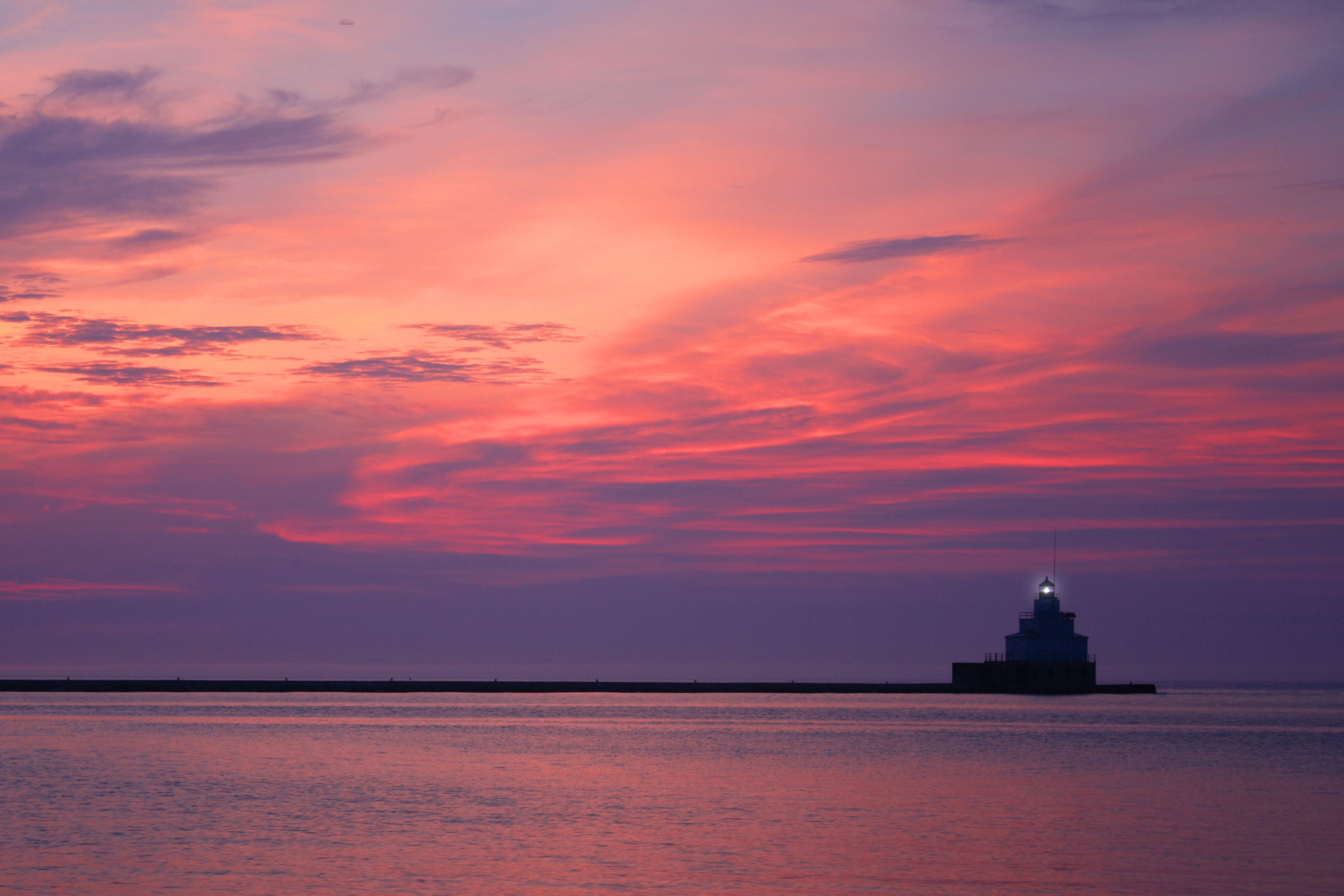
The Michigan Shipwreck Research Association now believes they have finally found the Hume, over a hundred years after its disappearance, but since it has sunk to a depth of over 150 feet, reaching it is complicated and requires divers to have a special mix of air when researching the wreck.
Another well known disappearance of the Michigan Triangle is that of George R. Donner, the captain of the O.S. McFarland. The vessel made it through the triangle, but the captain did not. He disappeared from his locked cabin, on April 28, 1937 — his 58th birthday.
The first documented airplane disappearance took place on June 23, 1950. Northwest Airlines Flight 2504 had 55 passengers and three crew members on board when it fell out of the sky over the Michigan Triangle. Though light debris and human bones were found floating in the lake, the large wreckage that should have been there was not. When the weather cleared, a massive search carried out by the Coast Guard turned up a blanket emblazoned with the airline’s logo and little else. Another disappearance occurred on July 3, 1998, when a Soviet aircraft that was participating in a local air show vanished as it flew over the lake.
Though most of the Michigan Triangle’s stories involve disappearances, during April and May of 2000, phantom planes and other flying objects lit up the radar screens in nearby air traffic control towers and on flights overhead. At least a dozen blips were officially recorded, but as many as a hundred were reported and they wreaked havoc in the skies. Pilots veered to avoid things that weren’t there and controllers tried to direct planes away from mid-air collisions that didn’t exist. In fact, there have been so many sightings of unidentified flying objects and phantom planes by both radar machines and the human eye that the Federal Aviation Administration created a special lake reporting service to catalog them all. Since the crowded skies of 2000, UFO sightings have continued in the area consistently, but at a lower rate of 10 to 20 per year.
Aokigahara Forest
Mount Fuji, Japan
There is nothing disconcerting about finding a forest to traipse through, unless you have chosen Aokigahara Forest. Also known as the Sea of Trees, this truly unwelcoming forest has been associated with Japanese demons and bad luck for decades and getting through this unsettling place is difficult at best.
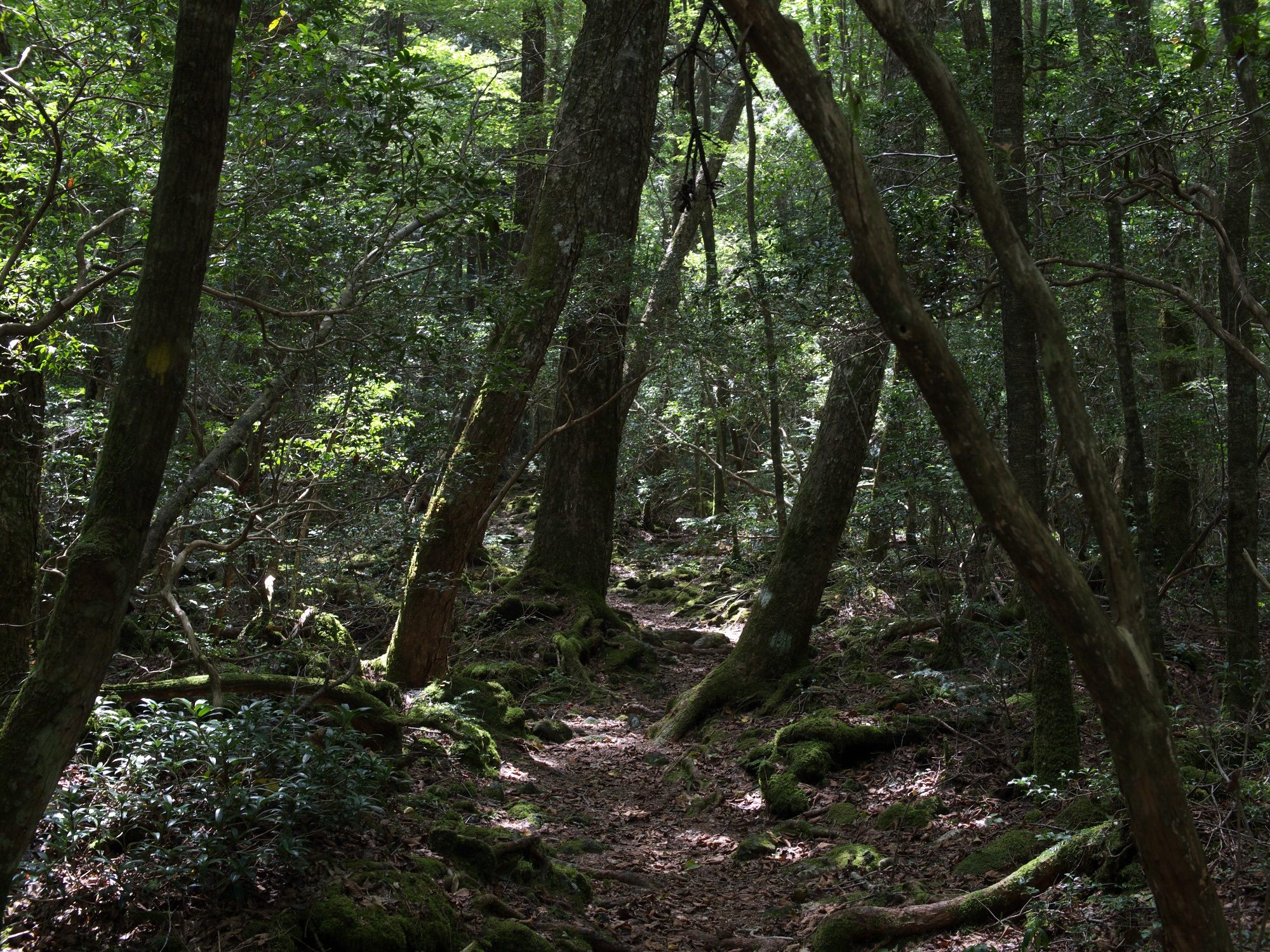
Due to the density of the trees, very little wind blows in the forest. There is a distinct lack of wildlife that makes everything quiet — too quiet — and it is believed that the Japanese custom of Ubasute was practiced here into the 19th century. This custom involved taking the elderly and infirm into a remote location and leaving them to perish in the elements. It has been said that the forest is haunted by the Yurei — the angry spirits of those who were left to die.
Aokigahara Forest is also one of the most popular locations for suicide in the world, rivaling San Francisco’s Golden Gate Bridge. It is such a widespread problem that there are anti-suicide signs posted along the trails in both Japanese and English. One says “Think of your families” and others push the visitors to reconsider any suicidal thoughts and get help. In recent years, the government has ceased to publish the actual number of yearly suicides, but the need for an annual “Body Hunt” carried out by volunteers speaks volumes.
The forest is so thick that bodies can go undiscovered for years at a time. Visitors who plan to reemerge after their visit have started laying down tape, string, or other proverbial bread crumbs behind them for when they need to retrace their steps. The ground is littered with these trails, but authorities say that the forest loses all trace of human contact deeper into the trees, with the exception of the occasional suicide of course. Locals have said that there are three types of visitors to Aokigahara Suicide Forest — those who are interested in the macabre, hikers who want pristine views of Mount Fiji, and those who don’t plan on returning.
Hampton Court Hedge Maze
Hampton Court Palace, England
The Hampton Court Maze is the one of the most popular mazes in the world and is the oldest surviving hedge maze in Great Britain. It was designed by George London and Henry Wise and was planted sometime between 1689 and 1695 after being commissioned by William III of Orange. It covers about 1/3 of an acre, and you can travel over half a mile on the paths within it.

This maze is not as intricate or difficult to navigate as some of the more modern mazes of the world, such as Adrian Fisher’s Labyrinthe Des Dragons, but it has been confusing people for well over 300 years. Some believe it is even older and that it was built to replace a maze that may have entertained the court of Henry VIII. Throughout the centuries of use, there have been multiple accounts of visitors getting hopelessly lost in the twists and turns and numerous literary references to the maze.
Perhaps the most famous is from Jerome K. Jerome’s 1889 semi-biographical and comic novel, Three Men In a Boat. In it, he describes a trip into the maze that begins with a scornful confidence and ends with a plea to the groundskeeper for help in trying to find a way out. Most visitors average a 30-45 minute trek through the hedges — though many have taken a lot longer to conquer the labyrinth. Recent updates to the Hampton Court Maze include a soundtrack which is a permanent audio installation called “Trace.” It features snippets of classical music, rustles of silk, whispers, and hushed giggles that fade in and out as you turn the corners, adding another disorienting touch to the oldest hedge maze in England.
Orfield Labs
Minneapolis, Minnesota
There’s a saying that silence is the loudest noise. At Orfield Laboratories, they prove that statement to be unequivocally true in their anechoic chamber. The healthy human ear can typically hear sounds at 0 decibels and above, but Orfield Lab’s silent room measures in at a whopping -9.4dBA, making the room completely devoid of detectable noise and earning it a mention in the 2005 Guinness Book of World Records as the “World’s Quietest Place. Anechoic chambers are designed to absorb sound and electromagnetic waves. They are insulated against any outside noise or interference and absorb energy in all directions, leaving a dead zone of quiet. When you consider that the average human conversation measures in at 30 decibels, a chamber that measures that far in the negative is quite disconcerting. When you are inside the small room the only noises you hear are your own, and when your body becomes the only source of sound, the volume of everyday functions seems deafeningly loud. Some people start hallucinating. Many feel like they are going crazy and all leave the room relatively quickly. Most visitors cannot last 45 minutes in the dark room at Orfield Labs. In fact, Steven Orfield himself can only do 30.

There are many uses for a room that is devoid of vibrations and sound. Companies use anechoic chambers to measure the sound levels of their products, such as motorcycles or large appliances. This technology has gotten the attention of NASA, and it has begun stress testing astronauts in a similar room before sending them into space.
Orfield Laboratories’ anechoic chamber has generated so much press and interest that Steven Orfield is considering making the “45 Minute Challenge” available to the general public. He is also working with the Guinness Book of World Records to record the longest time that anyone has been in able to stay in the chamber.
Funny enough, the building itself already had a totally different Guinness Record of its own. Prior to becoming Orfield Labs, the building housed Sound 80 — a recording studio that was frequented by musicians such as Prince and Dave Brubeck. It is credited in the Guinness World Records as being the Oldest Digital Recording Studio, before it was silenced by the anechoic chamber.
Dialogue in the Dark
Frankfurt, Germany
Have you ever wondered what it would be like to lose one of your senses? Dialogue in the Dark offers insight into how it would feel to lose your sight, and it is determined to change the perceptions of blindness in general society. Their goal is to raise awareness and create more tolerance for “otherness.” In order to accomplish this, they provide a disorienting experience in patience.

Dialogue in the Dark was founded by Andreas Heinecke, who was changed by his experience working with a man who was blinded in an auto accident. Dialogue has traveled the world over as an exhibition, but has found a permanent home in Frankfurt, Germany, and many other cities throughout Europe, Asia, and Africa. The experience consists of a number of rooms that are specifically constructed to resemble places that we travel to in everyday life, but that suddenly feel unfamiliar when experienced blind. The simulated bustling street corner or noisy bar is a little more harrowing, and the boat ride and playground are whole different adventures when there is no way to see what’s around you. Using sound, motion, and simulated sets, Dialogue offers visitors the chance to know exactly what life would be like without sight. The experience usually lasts 60 to 90 minutes and is most often guided by people who are truly blind.
Aside from the permanent exhibition, Dialogue in the Dark in Frankfurt offers another way to explore the unseen. Dinner in the Dark, also known as Taste of Darkness follows the same principle and forces diners to use other senses while eating a meal. Like their co-workers in the exhibitions, the servers in the restaurant are usually blind.
Tianmen Skywalk
Hunan Province, China
There are many ways to test one’s limits in the world — especially when it comes to the common vertigo-inducing fear of heights. There are numerous tourist stops where you can pay for the privilege and stand on jutting glass platforms such as the one in the Grand Canyon and the newer glacier viewing platform in Austria. While these platforms will deliver a spectacular view and take a lot of bravery to step onto, they tend to be only a few feet from safe ground and easy to get off of if your heart begins to pound too quickly for comfort. This is not the case on the Tianmen Skywalk in China.

Tianmen translates literally to Heaven’s Gate and is named for a large natural cave that is located about halfway up the peak. The mountain stands over 5,000 feet high and is taller than most other mountains in the area. Tourists already flocked to the area for its beauty and to ride the four mile long cable car — the longest in the world of its type — through the park. After the Skywalk was born in 2011, those numbers grew. But it takes a lot of courage to tread the precarious path and many have reached it and turned around. It is certainly not for the faint of heart.
The Skywalk on Tianmen mountain perches crookedly 4,700 feet above the ground below. Aside from its dizzying height, this is no wide platform with an easy exit. It is a tiny, terrifying, and winding path that is eight feet thick, but only three feet wide. It is so high up that you can see other peaks below you — and it clings directly to the sheer cliff face of the mountain. On one side, you have the mountain and on the other, a handrail and a little glass are all that separates you from the drop. This glass walkway curves around the mountain for over 70 feet. There is nothing to obstruct the clear view in almost every direction, including down to the valley below if you have the guts to look between your feet. When you’re suspended that high in the sky, it is easy to believe you are walking on air.
It is indeed a pathway fit for Heaven’s Gate. It takes such courage to walk on that repair workers and glass cleaners have been incredibly hard to come by. Visitors who are brave enough to take the high road are asked to wear booties or overshoes in order to reduce scuffs and scratches, keeping the need for maintenance to a minimum.
Konghor Singing Sand Dunes
Mandalgovi, Mongolia
Deep in the heart of the Gobi desert in southern Mongolia, music is being made by the sand itself. The Khongor Sand Dunes are the largest in Mongolia. Some stand nearly half a mile high and the view from the top of the dunes is unbelievable, but this is not their only draw. These dunes like to talk back to you — or sing, you might say — and their booming voices are something strange and wonderful and very confusing to experience.

The Gobi desert is considered to be one of the harshest environments on the planet, with extreme temperatures and sudden seasonal changes. The desert provides very little for its travelers and trekking across it can be a huge endeavor. One of the only places where the landscape changes and offers respite is at the northern edge of the Khongor dunes. Here a startling oasis of green appears due to its proximity to the Khongor river. Relaxing there in the shadows of the dunes is a unique pleasure and makes listening to their song even more surreal.
The Khongor dunes stretch for over 100 miles, can reach up to 12 miles across, and are known to boom or sing regularly. When a sand dune sings, its song is deep and rumbling. It is similar to a deep note on a didgeridoo and can last for several minutes at a time. Its voice can be heard for miles. Though there are 40 different singing sand dunes in the world, scientists are playing catch up with the phenomenon and are only recently figuring out what makes this disorienting eerie song possible. It is thought that the type of sand, its miniscule size, and the degree of humidity must combine perfectly with a small landslide or shifting of the sand for the dunes to produce a rumble.
New research indicates that there are many layers of sand within the singing dunes that are as hard as concrete, created by rainfall or salty water being drawn up by the sun. These layers of calcium carbonate under the surface act like a web for all the noises caused by sand avalanches, desert winds, and motion. It traps these noises and combines them, sending out one giant voice. The surface of the dune acts like an amplifier making the released rumble louder and louder. The regular climbers, strong desert wind, and constant shifting of surface sand helps continue this phenomenon in the Gobi.
Campbell Bros. Confusion Hill
Piercy, California
When visiting California’s redwood forest, one can find numerous roadside attractions and tourist traps, including drive through trees, larger-than-life statues of lumberjacks, and the largest wood carvings in the world. The Campbell Bros. Confusion Hill, located in Piercy, California is the most disorienting of such places, designed from the very beginning to knock you off your game and confuse your senses.
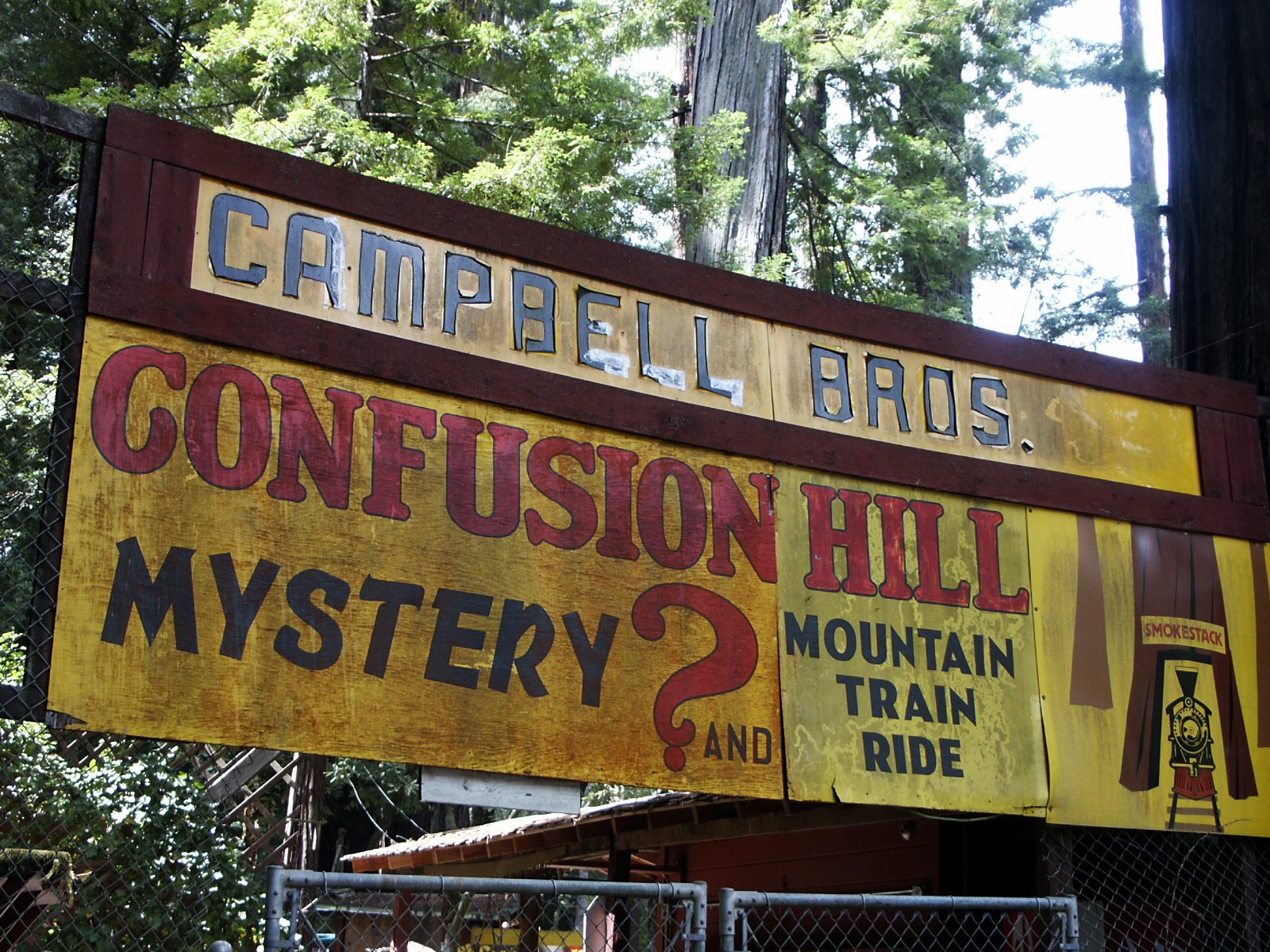
Confusion Hill hosts a manmade structure designed to mimic a gravity hill. It was built in 1949 by George Hudson who was on a quest to create a place that defied the laws of gravity and magnetism and proved that what we define as natural laws can still be manipulated and changed. It was this concept that drove him to create Confusion Hill.
In one section of the Gravity House, water appears to flow upward and in another, when you throw a ball it comes right back at you. When you walk from one side of a room to the other, you may feel as though your body has shrunk and then grown taller. In other parts of the house your eyes will be tricked into thinking that you are walking on walls, rather than the ground. The body’s responses to this assault on what we usually think and see often include dizziness and confusion, and visitors have also described a tingly feeling or a slight touch of nausea after spending a lot of time in the structure.
Confusion Hill’s popularity has continued even after it was sold to the Campbell Brothers at the end of 1999. When one of the brothers, Engineer Don, passed away in 2002, other strange things started occurring. The train has been known to move by itself and the whistle blows eerily at all hours of the night. The ghost of Engineer Don likes to rearrange tools and make mischief for his family, adding to the strangeness of the Hill.
This roadside attraction has not changed much since it was built and is one of approximately 40 mystery spots or gravity hills in the US alone. It differs from many others by allowing you to explore the house and the grounds at will and get totally disoriented for as long as you like. When you do, even though you know that it’s full of angles and optical illusions, you may still be unable to resist the urge to stand up straight. You may also find that you already are.
Chand Baori
Rajasthan, India
Chand Baori is the among the largest step wells in the world and has been in use for over 1,000 years. It was completed sometime between 800 and 900 AD and was intended to conserve as much water as possible in the arid, desert climate of eastern Rajasthan, India. It is not your typical well. This amazing structure resembles an M.C. Escher painting with staircases going up and down in perfect symmetry for more than 13 stories. It’s a dizzying display of Indian architecture. The 3,500 narrow steps descend over 65 feet to a murky pool of water that was the village’s only dependable water supply for centuries.
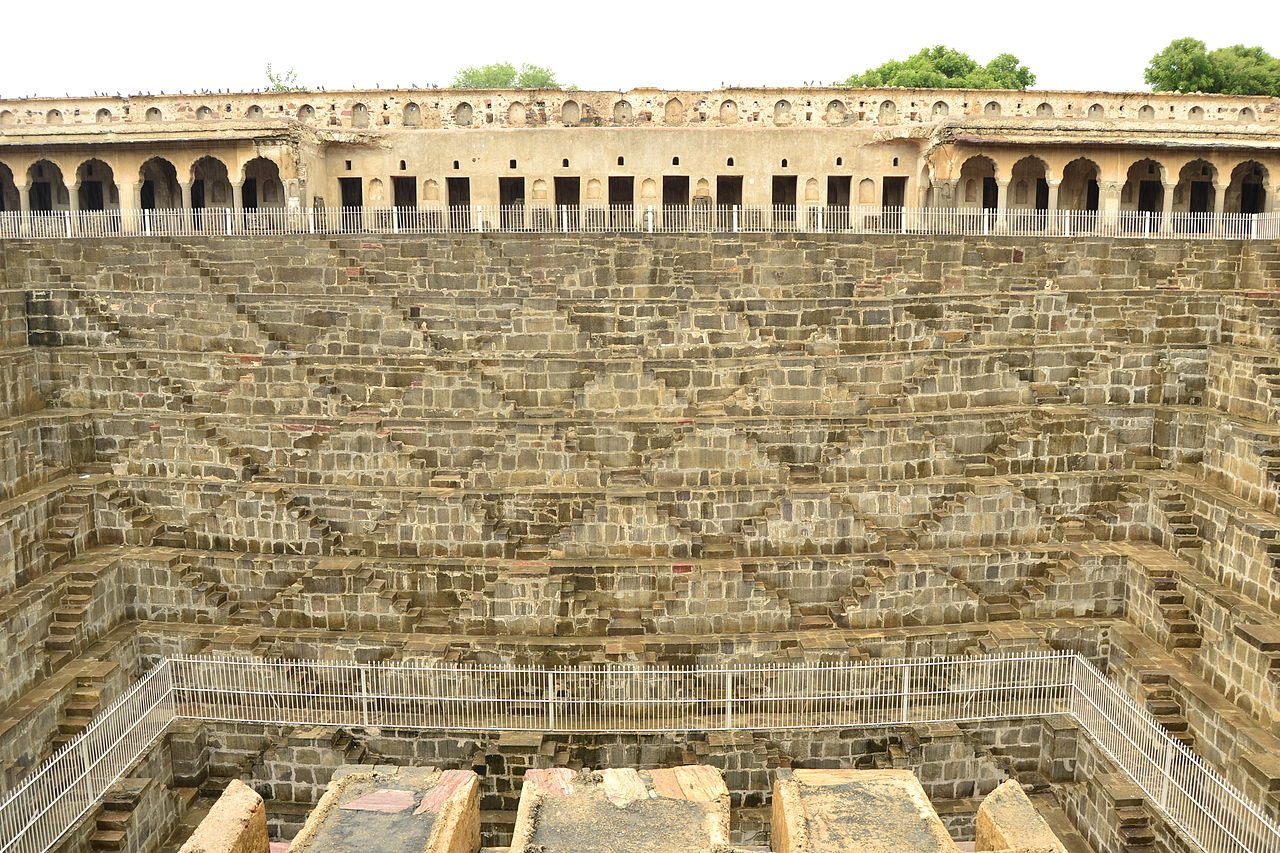
Step wells are unique to this region and are substantially larger than average wells. When working, Chand Baori’s wide mouth worked like a funnel and captured as much of the rare rainwater as possible which was added to the water seeping up from the porous rocks on the ground below. The depth ensured that little to none of the water was wasted through evaporation and it also helped keep the water cool. The air toward the bottom of the well is typically at least five degrees cooler than the surface and was used for decades as a place of respite from the heat where villagers could socialize, pray, or watch the occasional performance.
Three out of four walls are covered with ascending and descending stairs, while the fourth is reserved for alcoves or pavilions stacked on top of each other. These alcoves were filled with religious statues, rooms for royalty and those they favored to relax in.
Chand Baori is no longer used as a water supply, as you might guess from the murky and green tone of the water at its base. It is now a spectacular structure of Indian history and a favorite off the beaten path destination in India. There is a temple to the goddess adjacent to the well and they are both maintained and managed by the Archeological Survey of India. But all this aside, looking down at those treacherous stairs going off in every direction is definitely one of the world’s most spectacularly dizzying and disorienting views.
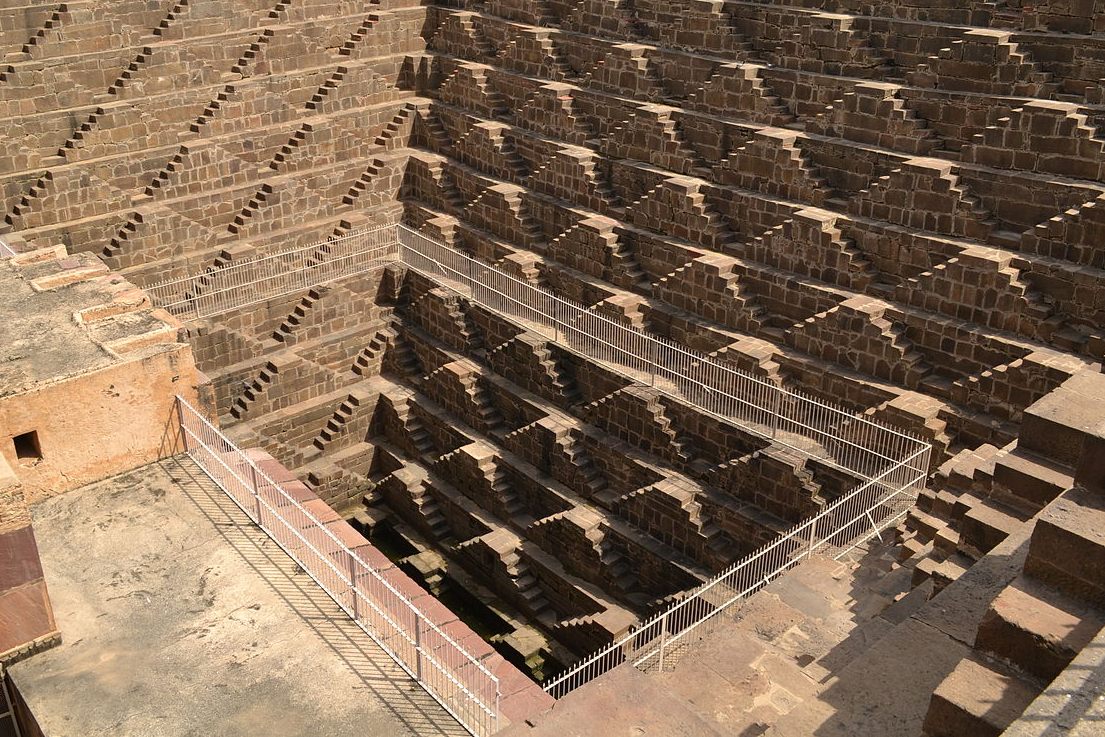




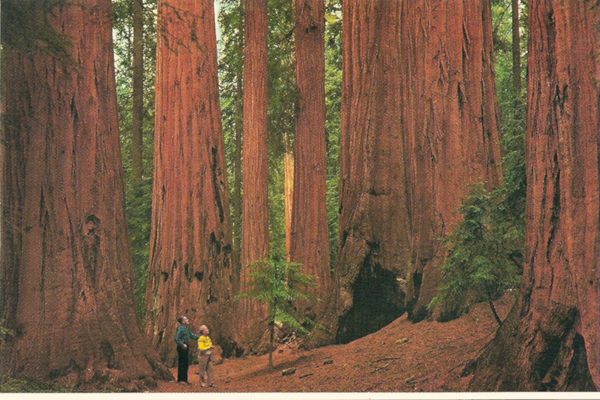






Follow us on Twitter to get the latest on the world's hidden wonders.
Like us on Facebook to get the latest on the world's hidden wonders.
Follow us on Twitter Like us on Facebook